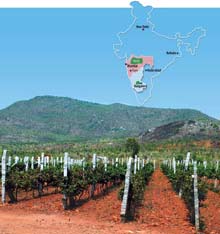Wine country

Twenty-five million Indians are drinking wine as you read this piece—that’s over six times the entire population of Guinness-drinking Ireland. And they are not just sipping Indian varietals. Everything from the best of Bordeaux and Napa Valley to Australia’s Jacob’s Creek and Italy’s Gaja wines—is now just a walk-to-the liquor-store away.
But here’s what will really light up the eyes of wine makers, importers and entrepreneurs across the world: 25 million is just 2 per cent of India’s population. And they consume a mere 1.1 million cases of wines annually (each case contains 9 litres of wines). Market watchers predict that by 2012, 10 per cent of Indians will be drinking wine.
1. Red wines rule the taste buds of Indians |
The report, titled Comprehensive Study of the Indian Wine Market, says the annual growth rate of 20-25 per cent over the last six years will continue for the next eight years, at least, with more and more Indians taking to wine.
“The JBC International staff travelled to India for 21 days to conduct a practical on the ground research—travelling to Mumbai, Bangalore, Delhi and Goa and interacting with people from all walks of life,” says James Gore, the principal author of the monograph.
So, what are Indians drinking? “The tastes and preferences of the Indian population err towards still wines and, more specifically, table wines. A majority of sales has stayed on traditional red and white wines,” says Gore. While the current consumption is 1.1 million 9-litre cases at a value of $60 million (Rs 300 crore), it is poised to cross the 2-million cases mark by 2011.

The real growth story, however, is in domestic production. Sample this: there were only six Indian wineries in 2000. Today, the number has grown to 65. Around 85 per cent of these are located in Maharashtra— Nashik, Pune, Baramati and Sangli. In Dindori—an elite area of Nasik—land is sold for Rs 10 lakh per acre today. This same land was sold for Rs 2–3 lakh in 2004.
Between them, the top five players (Château Indage, Sula, Grover, Vinsura and Reveilo) produce over 920,000 cases of wines every year—a figure projected to be 1,700,000 by 2011 as relative newcomers on the block (Pernod Ricard, Mallya’s United Spirits and the multi award-winning new brand Château d’Ori) produce a further 480,000 cases by 2011.
It’s not just the men either. More and more women are joining the wine sipping brigade—a reason, experts say, the sale of red wines are going up (apparently, women prefer red wines to whites across the world). “A survey conducted on the members of a wine club in India showed that nearly 50 per cent of consumers were women and this segment is growing at 5 per cent every six months,” says Dharti Desai, CEO, Finewinesnmore.
|
The recession and economic gloom, notwithstanding, the wine industry in India is on a spirited upswing and at present, at least, nothing, not even a draconian regulatory system, can stop its march. As Oldne concludes, quoting Napoleon Bonaparte: “In victory, you deserve Champagne, in defeat, you need it.”
Based on the report Comprehensive Study of the Indian Wine Market made available by Indian Wine Academy












